ANALYSIS 13: Building Law and Consumer Protection in Construction
VerifiedAdded on 2020/02/24
|14
|3569
|42
Report
AI Summary
This report analyzes the application of Australian Consumer Law (ACL) within the construction industry, examining key aspects such as misrepresentation and unfair contract terms. It delves into the legal framework, including sections 18 and 29 of the ACL, which address misleading or deceptive conduct and false representations, respectively. The report explores the responsibilities of developers to provide accurate information and avoid misleading practices, while also considering the rights of buyers. Additionally, it discusses the implications of unfair contract terms in standard form contracts, emphasizing the importance of fair dealings and consumer protection. The report provides case examples and legal references to illustrate the practical application of ACL principles and the potential consequences of non-compliance for both developers and consumers. This report is designed to provide a comprehensive overview of the relevant laws and their practical implications in the construction sector.

Paraphrase This Document
Need a fresh take? Get an instant paraphrase of this document with our AI Paraphraser
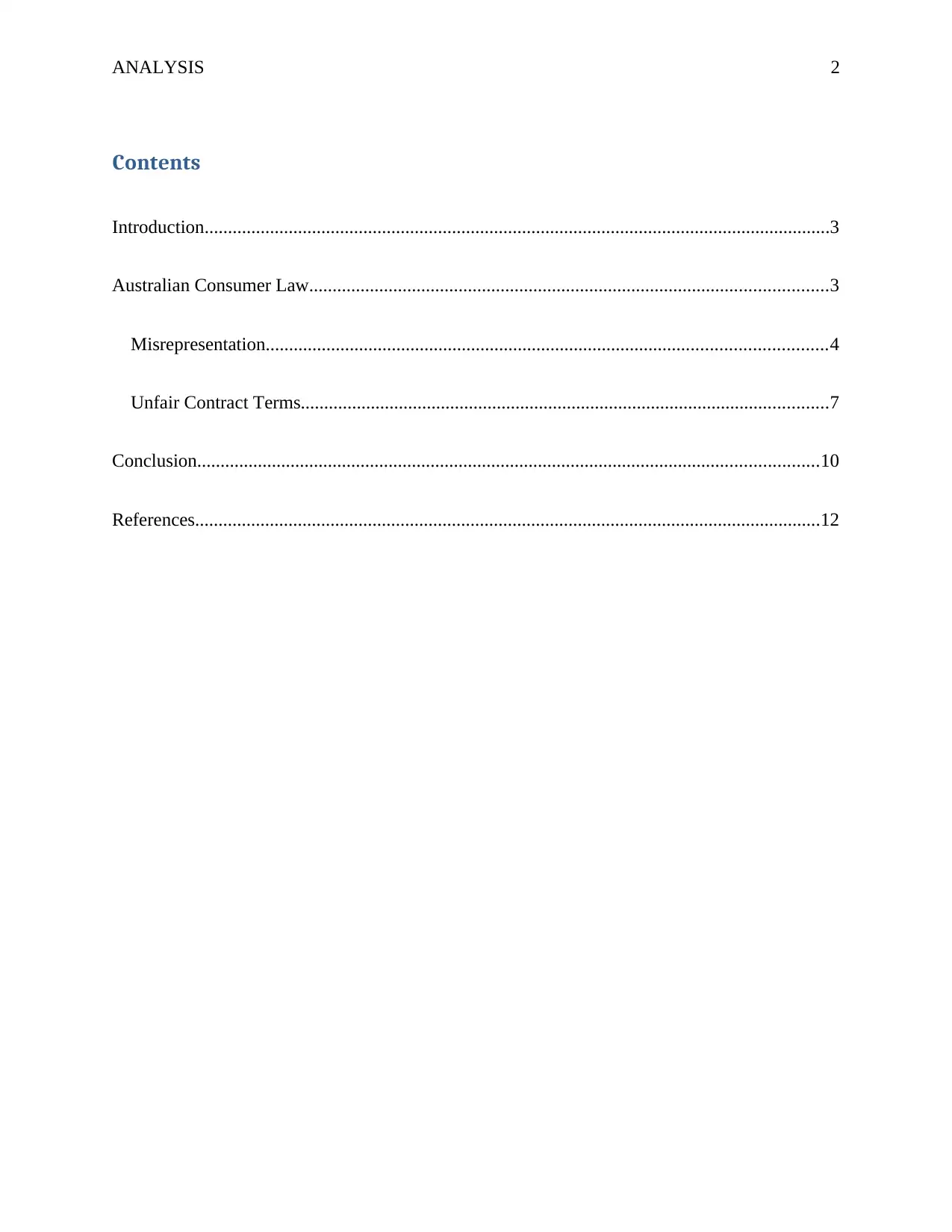
ANALYSIS 2
Contents
Introduction......................................................................................................................................3
Australian Consumer Law...............................................................................................................3
Misrepresentation........................................................................................................................4
Unfair Contract Terms.................................................................................................................7
Conclusion.....................................................................................................................................10
References......................................................................................................................................12
Contents
Introduction......................................................................................................................................3
Australian Consumer Law...............................................................................................................3
Misrepresentation........................................................................................................................4
Unfair Contract Terms.................................................................................................................7
Conclusion.....................................................................................................................................10
References......................................................................................................................................12
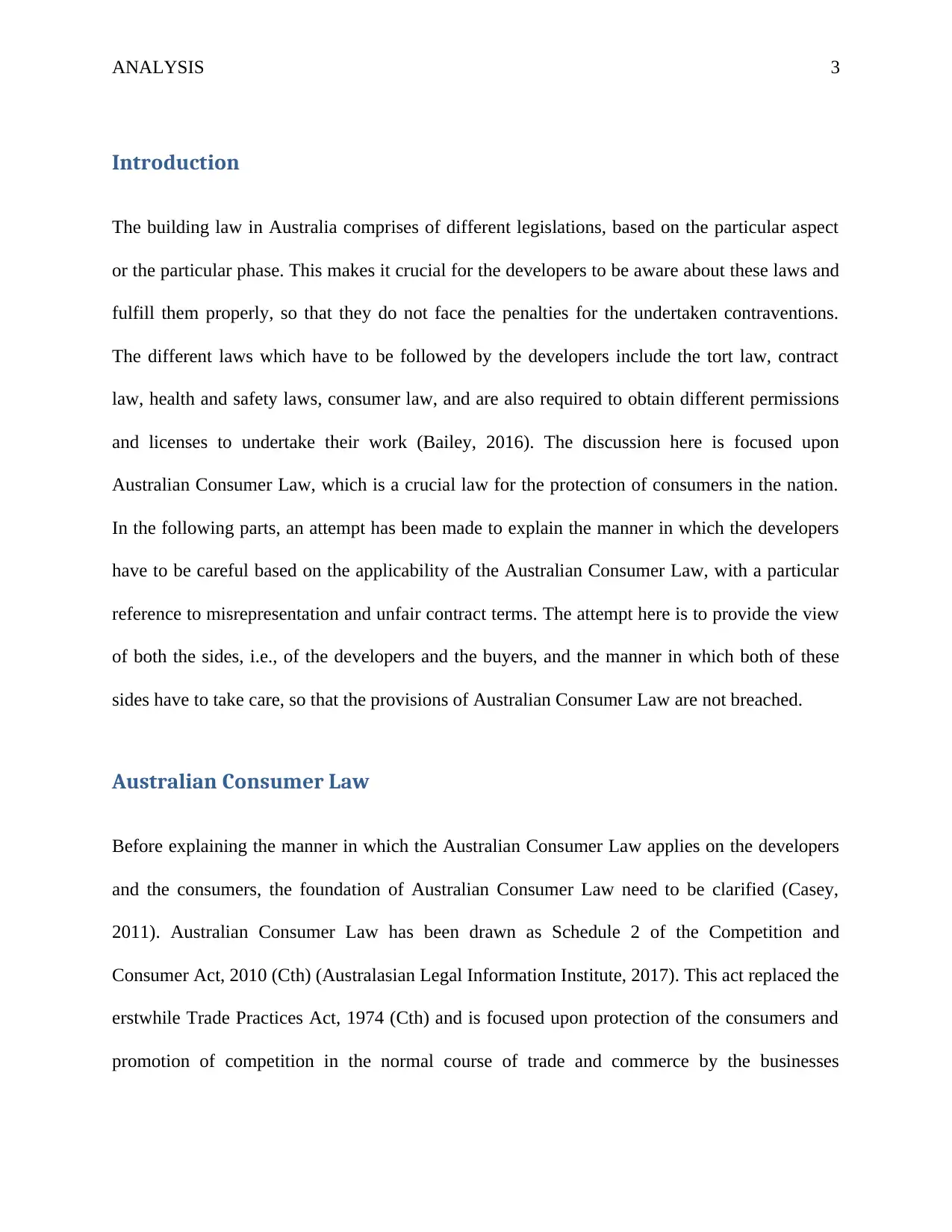
ANALYSIS 3
Introduction
The building law in Australia comprises of different legislations, based on the particular aspect
or the particular phase. This makes it crucial for the developers to be aware about these laws and
fulfill them properly, so that they do not face the penalties for the undertaken contraventions.
The different laws which have to be followed by the developers include the tort law, contract
law, health and safety laws, consumer law, and are also required to obtain different permissions
and licenses to undertake their work (Bailey, 2016). The discussion here is focused upon
Australian Consumer Law, which is a crucial law for the protection of consumers in the nation.
In the following parts, an attempt has been made to explain the manner in which the developers
have to be careful based on the applicability of the Australian Consumer Law, with a particular
reference to misrepresentation and unfair contract terms. The attempt here is to provide the view
of both the sides, i.e., of the developers and the buyers, and the manner in which both of these
sides have to take care, so that the provisions of Australian Consumer Law are not breached.
Australian Consumer Law
Before explaining the manner in which the Australian Consumer Law applies on the developers
and the consumers, the foundation of Australian Consumer Law need to be clarified (Casey,
2011). Australian Consumer Law has been drawn as Schedule 2 of the Competition and
Consumer Act, 2010 (Cth) (Australasian Legal Information Institute, 2017). This act replaced the
erstwhile Trade Practices Act, 1974 (Cth) and is focused upon protection of the consumers and
promotion of competition in the normal course of trade and commerce by the businesses
Introduction
The building law in Australia comprises of different legislations, based on the particular aspect
or the particular phase. This makes it crucial for the developers to be aware about these laws and
fulfill them properly, so that they do not face the penalties for the undertaken contraventions.
The different laws which have to be followed by the developers include the tort law, contract
law, health and safety laws, consumer law, and are also required to obtain different permissions
and licenses to undertake their work (Bailey, 2016). The discussion here is focused upon
Australian Consumer Law, which is a crucial law for the protection of consumers in the nation.
In the following parts, an attempt has been made to explain the manner in which the developers
have to be careful based on the applicability of the Australian Consumer Law, with a particular
reference to misrepresentation and unfair contract terms. The attempt here is to provide the view
of both the sides, i.e., of the developers and the buyers, and the manner in which both of these
sides have to take care, so that the provisions of Australian Consumer Law are not breached.
Australian Consumer Law
Before explaining the manner in which the Australian Consumer Law applies on the developers
and the consumers, the foundation of Australian Consumer Law need to be clarified (Casey,
2011). Australian Consumer Law has been drawn as Schedule 2 of the Competition and
Consumer Act, 2010 (Cth) (Australasian Legal Information Institute, 2017). This act replaced the
erstwhile Trade Practices Act, 1974 (Cth) and is focused upon protection of the consumers and
promotion of competition in the normal course of trade and commerce by the businesses
⊘ This is a preview!⊘
Do you want full access?
Subscribe today to unlock all pages.

Trusted by 1+ million students worldwide
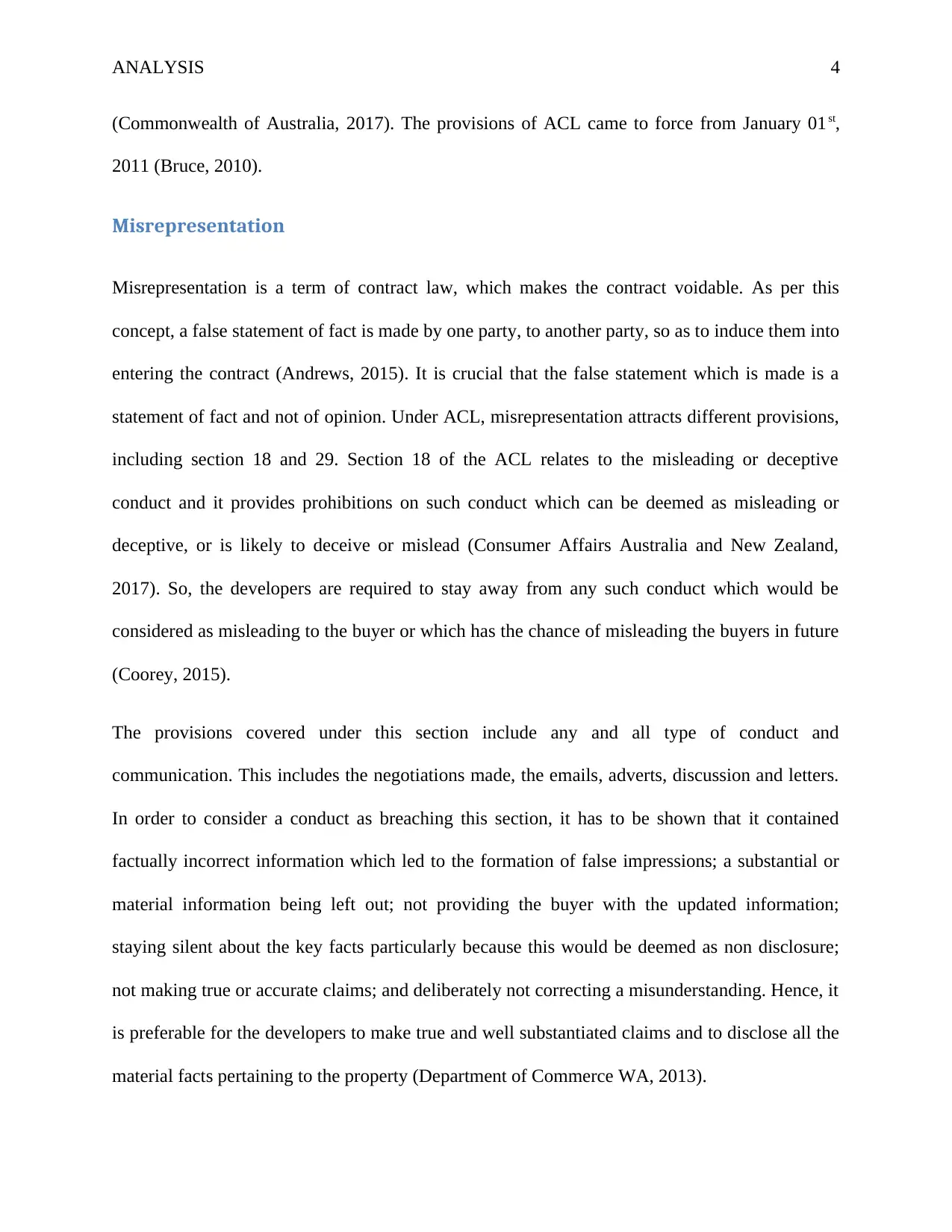
ANALYSIS 4
(Commonwealth of Australia, 2017). The provisions of ACL came to force from January 01st,
2011 (Bruce, 2010).
Misrepresentation
Misrepresentation is a term of contract law, which makes the contract voidable. As per this
concept, a false statement of fact is made by one party, to another party, so as to induce them into
entering the contract (Andrews, 2015). It is crucial that the false statement which is made is a
statement of fact and not of opinion. Under ACL, misrepresentation attracts different provisions,
including section 18 and 29. Section 18 of the ACL relates to the misleading or deceptive
conduct and it provides prohibitions on such conduct which can be deemed as misleading or
deceptive, or is likely to deceive or mislead (Consumer Affairs Australia and New Zealand,
2017). So, the developers are required to stay away from any such conduct which would be
considered as misleading to the buyer or which has the chance of misleading the buyers in future
(Coorey, 2015).
The provisions covered under this section include any and all type of conduct and
communication. This includes the negotiations made, the emails, adverts, discussion and letters.
In order to consider a conduct as breaching this section, it has to be shown that it contained
factually incorrect information which led to the formation of false impressions; a substantial or
material information being left out; not providing the buyer with the updated information;
staying silent about the key facts particularly because this would be deemed as non disclosure;
not making true or accurate claims; and deliberately not correcting a misunderstanding. Hence, it
is preferable for the developers to make true and well substantiated claims and to disclose all the
material facts pertaining to the property (Department of Commerce WA, 2013).
(Commonwealth of Australia, 2017). The provisions of ACL came to force from January 01st,
2011 (Bruce, 2010).
Misrepresentation
Misrepresentation is a term of contract law, which makes the contract voidable. As per this
concept, a false statement of fact is made by one party, to another party, so as to induce them into
entering the contract (Andrews, 2015). It is crucial that the false statement which is made is a
statement of fact and not of opinion. Under ACL, misrepresentation attracts different provisions,
including section 18 and 29. Section 18 of the ACL relates to the misleading or deceptive
conduct and it provides prohibitions on such conduct which can be deemed as misleading or
deceptive, or is likely to deceive or mislead (Consumer Affairs Australia and New Zealand,
2017). So, the developers are required to stay away from any such conduct which would be
considered as misleading to the buyer or which has the chance of misleading the buyers in future
(Coorey, 2015).
The provisions covered under this section include any and all type of conduct and
communication. This includes the negotiations made, the emails, adverts, discussion and letters.
In order to consider a conduct as breaching this section, it has to be shown that it contained
factually incorrect information which led to the formation of false impressions; a substantial or
material information being left out; not providing the buyer with the updated information;
staying silent about the key facts particularly because this would be deemed as non disclosure;
not making true or accurate claims; and deliberately not correcting a misunderstanding. Hence, it
is preferable for the developers to make true and well substantiated claims and to disclose all the
material facts pertaining to the property (Department of Commerce WA, 2013).
Paraphrase This Document
Need a fresh take? Get an instant paraphrase of this document with our AI Paraphraser
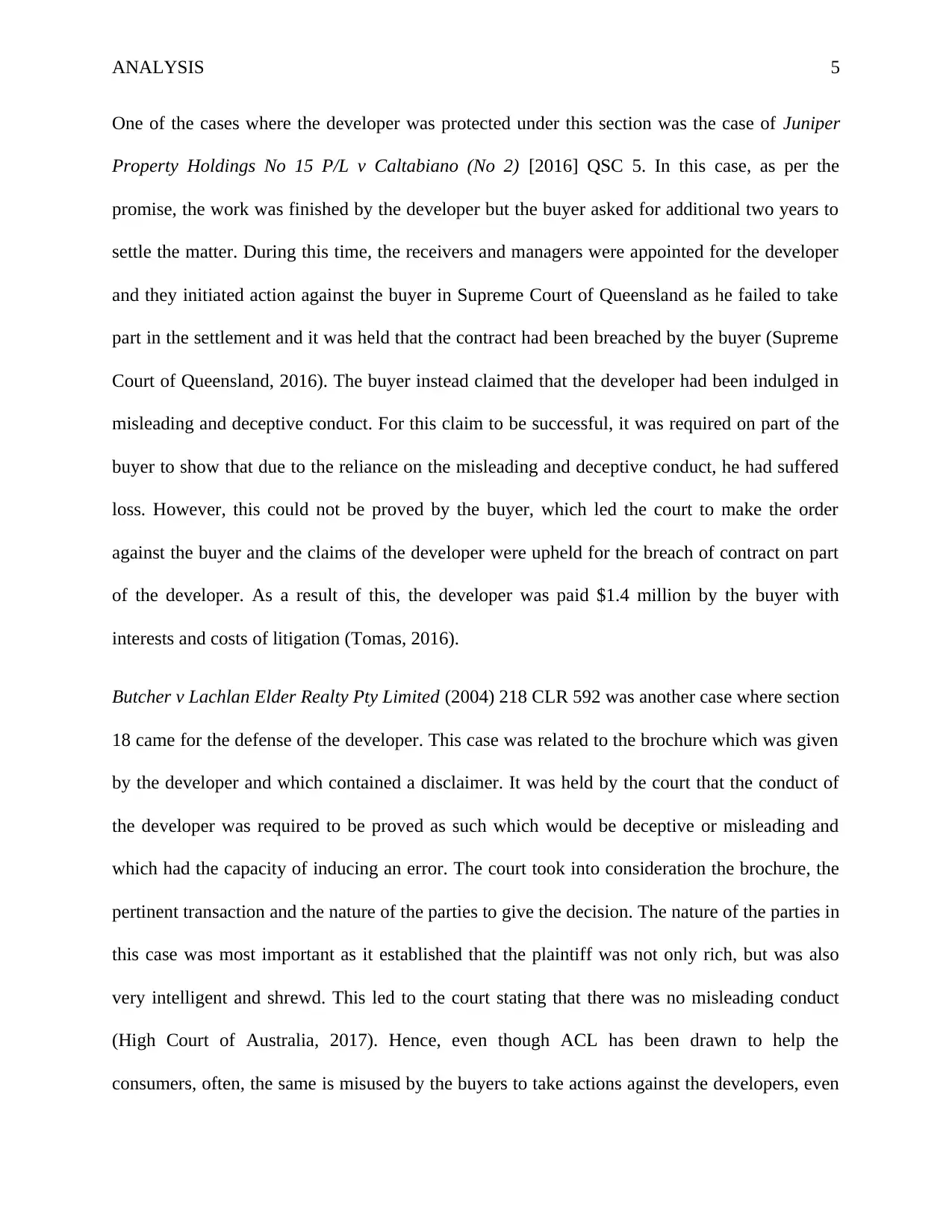
ANALYSIS 5
One of the cases where the developer was protected under this section was the case of Juniper
Property Holdings No 15 P/L v Caltabiano (No 2) [2016] QSC 5. In this case, as per the
promise, the work was finished by the developer but the buyer asked for additional two years to
settle the matter. During this time, the receivers and managers were appointed for the developer
and they initiated action against the buyer in Supreme Court of Queensland as he failed to take
part in the settlement and it was held that the contract had been breached by the buyer (Supreme
Court of Queensland, 2016). The buyer instead claimed that the developer had been indulged in
misleading and deceptive conduct. For this claim to be successful, it was required on part of the
buyer to show that due to the reliance on the misleading and deceptive conduct, he had suffered
loss. However, this could not be proved by the buyer, which led the court to make the order
against the buyer and the claims of the developer were upheld for the breach of contract on part
of the developer. As a result of this, the developer was paid $1.4 million by the buyer with
interests and costs of litigation (Tomas, 2016).
Butcher v Lachlan Elder Realty Pty Limited (2004) 218 CLR 592 was another case where section
18 came for the defense of the developer. This case was related to the brochure which was given
by the developer and which contained a disclaimer. It was held by the court that the conduct of
the developer was required to be proved as such which would be deceptive or misleading and
which had the capacity of inducing an error. The court took into consideration the brochure, the
pertinent transaction and the nature of the parties to give the decision. The nature of the parties in
this case was most important as it established that the plaintiff was not only rich, but was also
very intelligent and shrewd. This led to the court stating that there was no misleading conduct
(High Court of Australia, 2017). Hence, even though ACL has been drawn to help the
consumers, often, the same is misused by the buyers to take actions against the developers, even
One of the cases where the developer was protected under this section was the case of Juniper
Property Holdings No 15 P/L v Caltabiano (No 2) [2016] QSC 5. In this case, as per the
promise, the work was finished by the developer but the buyer asked for additional two years to
settle the matter. During this time, the receivers and managers were appointed for the developer
and they initiated action against the buyer in Supreme Court of Queensland as he failed to take
part in the settlement and it was held that the contract had been breached by the buyer (Supreme
Court of Queensland, 2016). The buyer instead claimed that the developer had been indulged in
misleading and deceptive conduct. For this claim to be successful, it was required on part of the
buyer to show that due to the reliance on the misleading and deceptive conduct, he had suffered
loss. However, this could not be proved by the buyer, which led the court to make the order
against the buyer and the claims of the developer were upheld for the breach of contract on part
of the developer. As a result of this, the developer was paid $1.4 million by the buyer with
interests and costs of litigation (Tomas, 2016).
Butcher v Lachlan Elder Realty Pty Limited (2004) 218 CLR 592 was another case where section
18 came for the defense of the developer. This case was related to the brochure which was given
by the developer and which contained a disclaimer. It was held by the court that the conduct of
the developer was required to be proved as such which would be deceptive or misleading and
which had the capacity of inducing an error. The court took into consideration the brochure, the
pertinent transaction and the nature of the parties to give the decision. The nature of the parties in
this case was most important as it established that the plaintiff was not only rich, but was also
very intelligent and shrewd. This led to the court stating that there was no misleading conduct
(High Court of Australia, 2017). Hence, even though ACL has been drawn to help the
consumers, often, the same is misused by the buyers to take actions against the developers, even
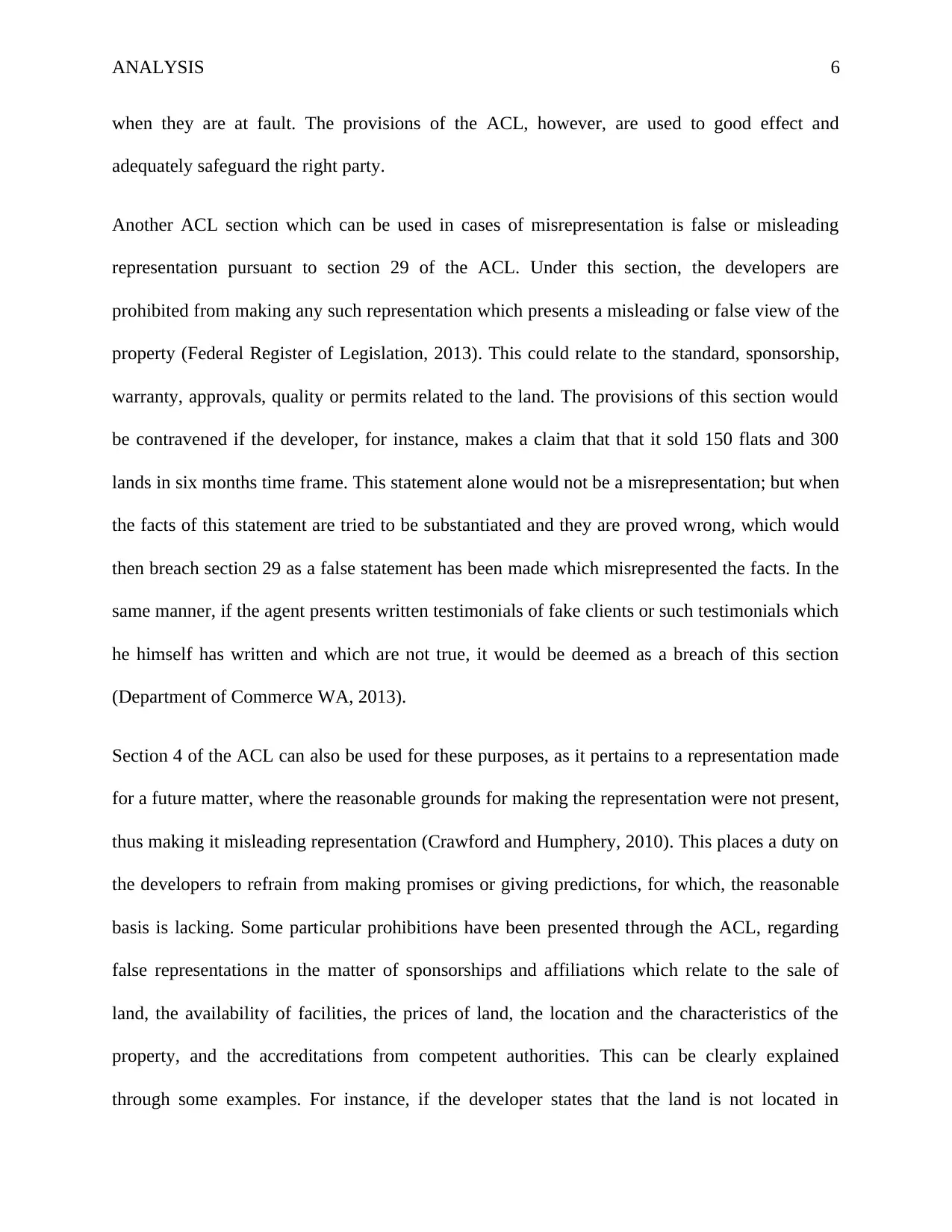
ANALYSIS 6
when they are at fault. The provisions of the ACL, however, are used to good effect and
adequately safeguard the right party.
Another ACL section which can be used in cases of misrepresentation is false or misleading
representation pursuant to section 29 of the ACL. Under this section, the developers are
prohibited from making any such representation which presents a misleading or false view of the
property (Federal Register of Legislation, 2013). This could relate to the standard, sponsorship,
warranty, approvals, quality or permits related to the land. The provisions of this section would
be contravened if the developer, for instance, makes a claim that that it sold 150 flats and 300
lands in six months time frame. This statement alone would not be a misrepresentation; but when
the facts of this statement are tried to be substantiated and they are proved wrong, which would
then breach section 29 as a false statement has been made which misrepresented the facts. In the
same manner, if the agent presents written testimonials of fake clients or such testimonials which
he himself has written and which are not true, it would be deemed as a breach of this section
(Department of Commerce WA, 2013).
Section 4 of the ACL can also be used for these purposes, as it pertains to a representation made
for a future matter, where the reasonable grounds for making the representation were not present,
thus making it misleading representation (Crawford and Humphery, 2010). This places a duty on
the developers to refrain from making promises or giving predictions, for which, the reasonable
basis is lacking. Some particular prohibitions have been presented through the ACL, regarding
false representations in the matter of sponsorships and affiliations which relate to the sale of
land, the availability of facilities, the prices of land, the location and the characteristics of the
property, and the accreditations from competent authorities. This can be clearly explained
through some examples. For instance, if the developer states that the land is not located in
when they are at fault. The provisions of the ACL, however, are used to good effect and
adequately safeguard the right party.
Another ACL section which can be used in cases of misrepresentation is false or misleading
representation pursuant to section 29 of the ACL. Under this section, the developers are
prohibited from making any such representation which presents a misleading or false view of the
property (Federal Register of Legislation, 2013). This could relate to the standard, sponsorship,
warranty, approvals, quality or permits related to the land. The provisions of this section would
be contravened if the developer, for instance, makes a claim that that it sold 150 flats and 300
lands in six months time frame. This statement alone would not be a misrepresentation; but when
the facts of this statement are tried to be substantiated and they are proved wrong, which would
then breach section 29 as a false statement has been made which misrepresented the facts. In the
same manner, if the agent presents written testimonials of fake clients or such testimonials which
he himself has written and which are not true, it would be deemed as a breach of this section
(Department of Commerce WA, 2013).
Section 4 of the ACL can also be used for these purposes, as it pertains to a representation made
for a future matter, where the reasonable grounds for making the representation were not present,
thus making it misleading representation (Crawford and Humphery, 2010). This places a duty on
the developers to refrain from making promises or giving predictions, for which, the reasonable
basis is lacking. Some particular prohibitions have been presented through the ACL, regarding
false representations in the matter of sponsorships and affiliations which relate to the sale of
land, the availability of facilities, the prices of land, the location and the characteristics of the
property, and the accreditations from competent authorities. This can be clearly explained
through some examples. For instance, if the developer states that the land is not located in
⊘ This is a preview!⊘
Do you want full access?
Subscribe today to unlock all pages.

Trusted by 1+ million students worldwide
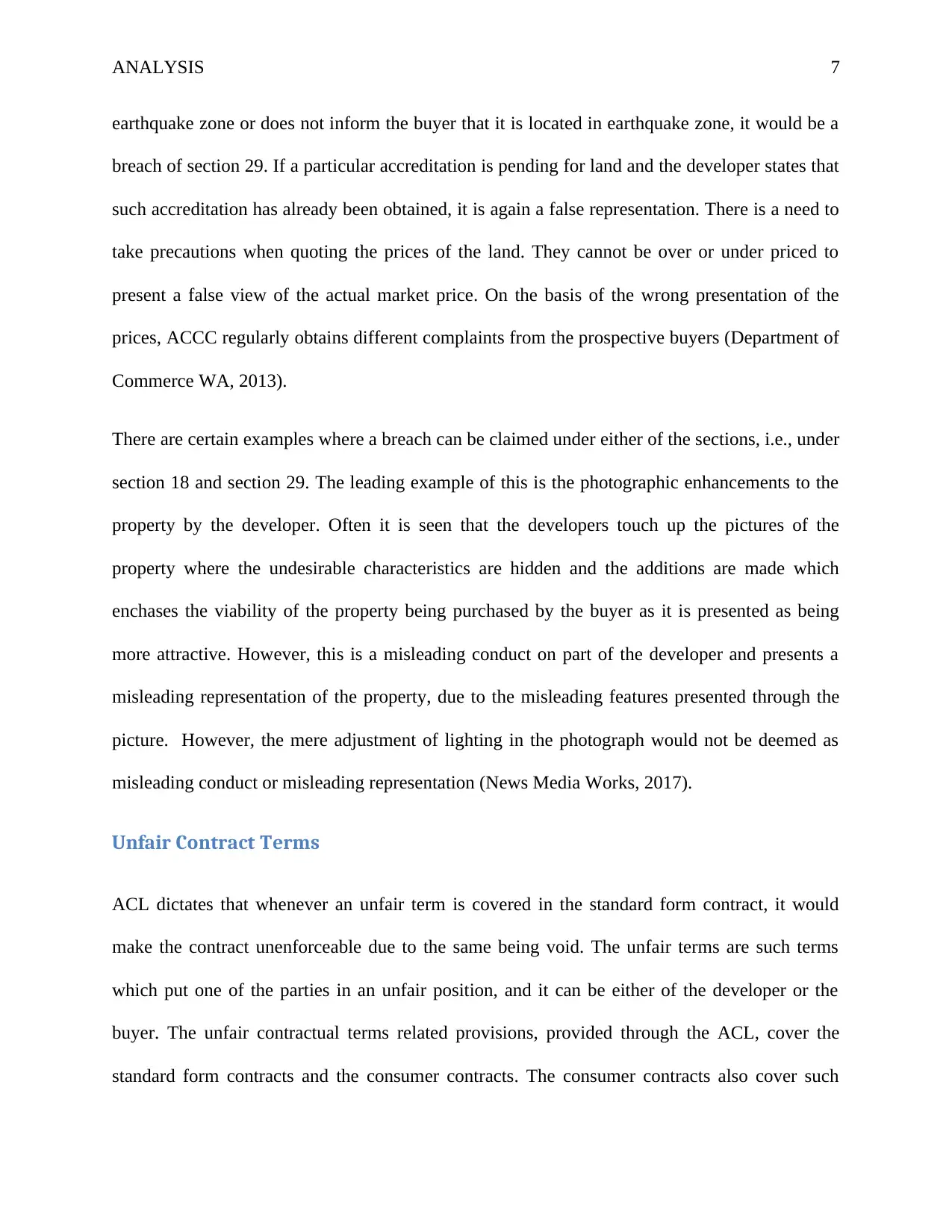
ANALYSIS 7
earthquake zone or does not inform the buyer that it is located in earthquake zone, it would be a
breach of section 29. If a particular accreditation is pending for land and the developer states that
such accreditation has already been obtained, it is again a false representation. There is a need to
take precautions when quoting the prices of the land. They cannot be over or under priced to
present a false view of the actual market price. On the basis of the wrong presentation of the
prices, ACCC regularly obtains different complaints from the prospective buyers (Department of
Commerce WA, 2013).
There are certain examples where a breach can be claimed under either of the sections, i.e., under
section 18 and section 29. The leading example of this is the photographic enhancements to the
property by the developer. Often it is seen that the developers touch up the pictures of the
property where the undesirable characteristics are hidden and the additions are made which
enchases the viability of the property being purchased by the buyer as it is presented as being
more attractive. However, this is a misleading conduct on part of the developer and presents a
misleading representation of the property, due to the misleading features presented through the
picture. However, the mere adjustment of lighting in the photograph would not be deemed as
misleading conduct or misleading representation (News Media Works, 2017).
Unfair Contract Terms
ACL dictates that whenever an unfair term is covered in the standard form contract, it would
make the contract unenforceable due to the same being void. The unfair terms are such terms
which put one of the parties in an unfair position, and it can be either of the developer or the
buyer. The unfair contractual terms related provisions, provided through the ACL, cover the
standard form contracts and the consumer contracts. The consumer contracts also cover such
earthquake zone or does not inform the buyer that it is located in earthquake zone, it would be a
breach of section 29. If a particular accreditation is pending for land and the developer states that
such accreditation has already been obtained, it is again a false representation. There is a need to
take precautions when quoting the prices of the land. They cannot be over or under priced to
present a false view of the actual market price. On the basis of the wrong presentation of the
prices, ACCC regularly obtains different complaints from the prospective buyers (Department of
Commerce WA, 2013).
There are certain examples where a breach can be claimed under either of the sections, i.e., under
section 18 and section 29. The leading example of this is the photographic enhancements to the
property by the developer. Often it is seen that the developers touch up the pictures of the
property where the undesirable characteristics are hidden and the additions are made which
enchases the viability of the property being purchased by the buyer as it is presented as being
more attractive. However, this is a misleading conduct on part of the developer and presents a
misleading representation of the property, due to the misleading features presented through the
picture. However, the mere adjustment of lighting in the photograph would not be deemed as
misleading conduct or misleading representation (News Media Works, 2017).
Unfair Contract Terms
ACL dictates that whenever an unfair term is covered in the standard form contract, it would
make the contract unenforceable due to the same being void. The unfair terms are such terms
which put one of the parties in an unfair position, and it can be either of the developer or the
buyer. The unfair contractual terms related provisions, provided through the ACL, cover the
standard form contracts and the consumer contracts. The consumer contracts also cover such
Paraphrase This Document
Need a fresh take? Get an instant paraphrase of this document with our AI Paraphraser
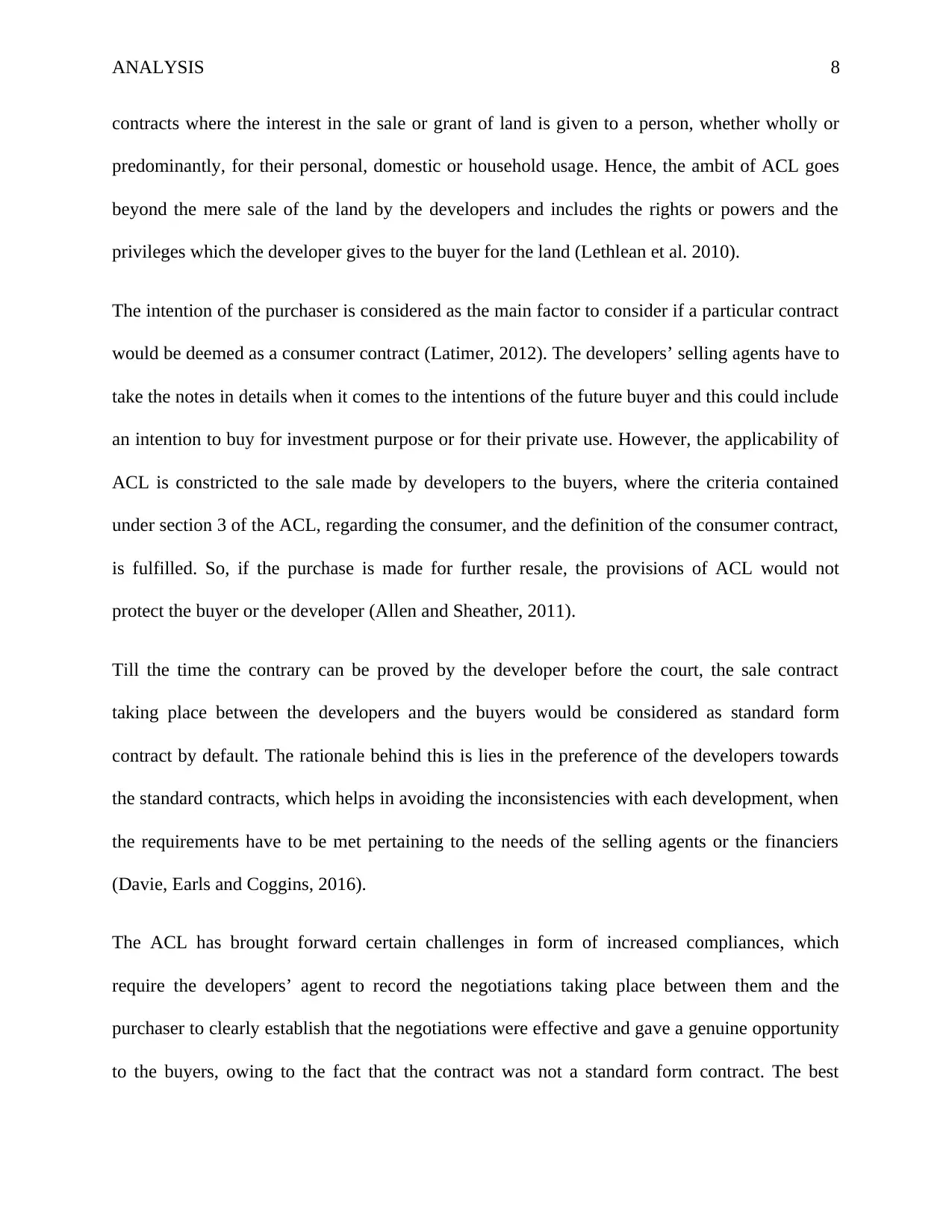
ANALYSIS 8
contracts where the interest in the sale or grant of land is given to a person, whether wholly or
predominantly, for their personal, domestic or household usage. Hence, the ambit of ACL goes
beyond the mere sale of the land by the developers and includes the rights or powers and the
privileges which the developer gives to the buyer for the land (Lethlean et al. 2010).
The intention of the purchaser is considered as the main factor to consider if a particular contract
would be deemed as a consumer contract (Latimer, 2012). The developers’ selling agents have to
take the notes in details when it comes to the intentions of the future buyer and this could include
an intention to buy for investment purpose or for their private use. However, the applicability of
ACL is constricted to the sale made by developers to the buyers, where the criteria contained
under section 3 of the ACL, regarding the consumer, and the definition of the consumer contract,
is fulfilled. So, if the purchase is made for further resale, the provisions of ACL would not
protect the buyer or the developer (Allen and Sheather, 2011).
Till the time the contrary can be proved by the developer before the court, the sale contract
taking place between the developers and the buyers would be considered as standard form
contract by default. The rationale behind this is lies in the preference of the developers towards
the standard contracts, which helps in avoiding the inconsistencies with each development, when
the requirements have to be met pertaining to the needs of the selling agents or the financiers
(Davie, Earls and Coggins, 2016).
The ACL has brought forward certain challenges in form of increased compliances, which
require the developers’ agent to record the negotiations taking place between them and the
purchaser to clearly establish that the negotiations were effective and gave a genuine opportunity
to the buyers, owing to the fact that the contract was not a standard form contract. The best
contracts where the interest in the sale or grant of land is given to a person, whether wholly or
predominantly, for their personal, domestic or household usage. Hence, the ambit of ACL goes
beyond the mere sale of the land by the developers and includes the rights or powers and the
privileges which the developer gives to the buyer for the land (Lethlean et al. 2010).
The intention of the purchaser is considered as the main factor to consider if a particular contract
would be deemed as a consumer contract (Latimer, 2012). The developers’ selling agents have to
take the notes in details when it comes to the intentions of the future buyer and this could include
an intention to buy for investment purpose or for their private use. However, the applicability of
ACL is constricted to the sale made by developers to the buyers, where the criteria contained
under section 3 of the ACL, regarding the consumer, and the definition of the consumer contract,
is fulfilled. So, if the purchase is made for further resale, the provisions of ACL would not
protect the buyer or the developer (Allen and Sheather, 2011).
Till the time the contrary can be proved by the developer before the court, the sale contract
taking place between the developers and the buyers would be considered as standard form
contract by default. The rationale behind this is lies in the preference of the developers towards
the standard contracts, which helps in avoiding the inconsistencies with each development, when
the requirements have to be met pertaining to the needs of the selling agents or the financiers
(Davie, Earls and Coggins, 2016).
The ACL has brought forward certain challenges in form of increased compliances, which
require the developers’ agent to record the negotiations taking place between them and the
purchaser to clearly establish that the negotiations were effective and gave a genuine opportunity
to the buyers, owing to the fact that the contract was not a standard form contract. The best
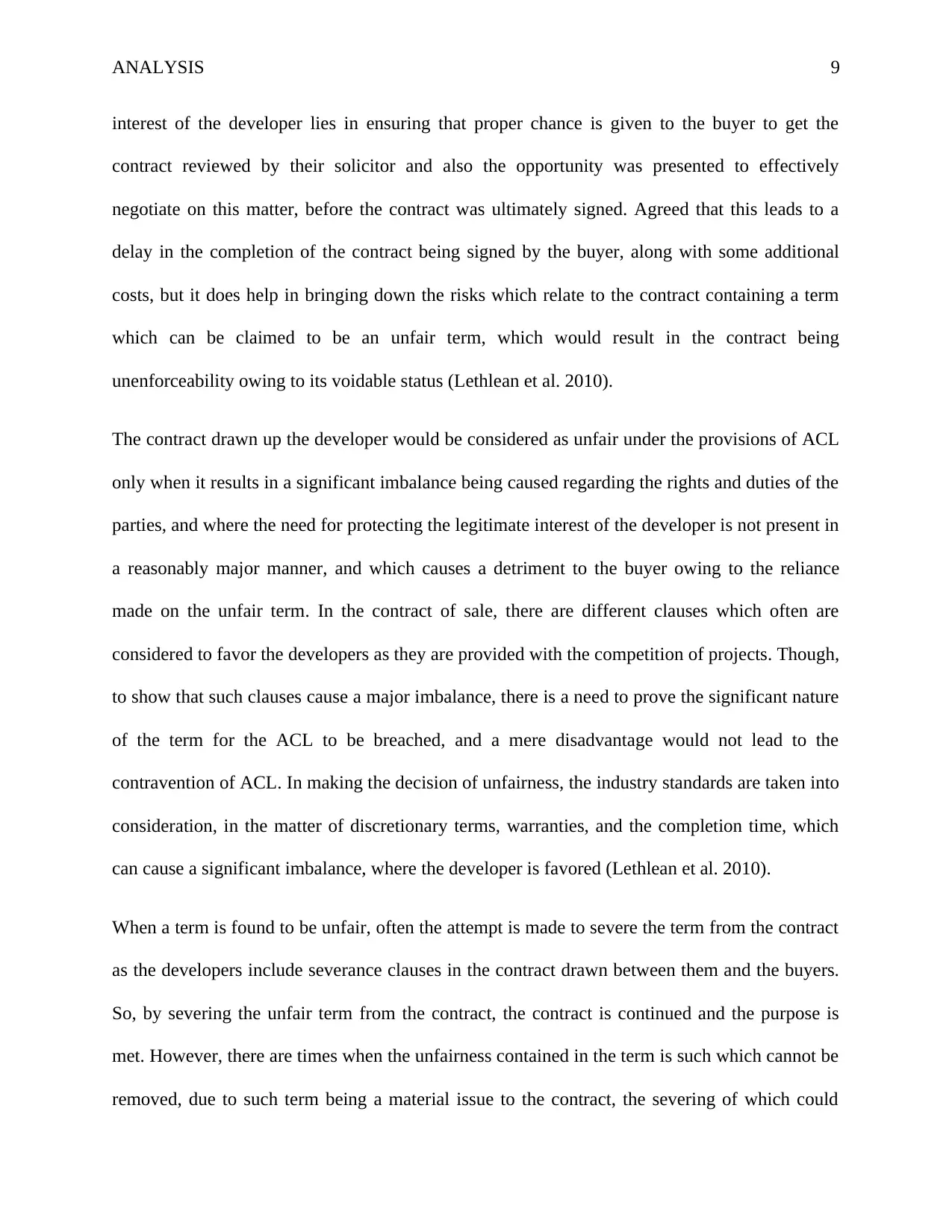
ANALYSIS 9
interest of the developer lies in ensuring that proper chance is given to the buyer to get the
contract reviewed by their solicitor and also the opportunity was presented to effectively
negotiate on this matter, before the contract was ultimately signed. Agreed that this leads to a
delay in the completion of the contract being signed by the buyer, along with some additional
costs, but it does help in bringing down the risks which relate to the contract containing a term
which can be claimed to be an unfair term, which would result in the contract being
unenforceability owing to its voidable status (Lethlean et al. 2010).
The contract drawn up the developer would be considered as unfair under the provisions of ACL
only when it results in a significant imbalance being caused regarding the rights and duties of the
parties, and where the need for protecting the legitimate interest of the developer is not present in
a reasonably major manner, and which causes a detriment to the buyer owing to the reliance
made on the unfair term. In the contract of sale, there are different clauses which often are
considered to favor the developers as they are provided with the competition of projects. Though,
to show that such clauses cause a major imbalance, there is a need to prove the significant nature
of the term for the ACL to be breached, and a mere disadvantage would not lead to the
contravention of ACL. In making the decision of unfairness, the industry standards are taken into
consideration, in the matter of discretionary terms, warranties, and the completion time, which
can cause a significant imbalance, where the developer is favored (Lethlean et al. 2010).
When a term is found to be unfair, often the attempt is made to severe the term from the contract
as the developers include severance clauses in the contract drawn between them and the buyers.
So, by severing the unfair term from the contract, the contract is continued and the purpose is
met. However, there are times when the unfairness contained in the term is such which cannot be
removed, due to such term being a material issue to the contract, the severing of which could
interest of the developer lies in ensuring that proper chance is given to the buyer to get the
contract reviewed by their solicitor and also the opportunity was presented to effectively
negotiate on this matter, before the contract was ultimately signed. Agreed that this leads to a
delay in the completion of the contract being signed by the buyer, along with some additional
costs, but it does help in bringing down the risks which relate to the contract containing a term
which can be claimed to be an unfair term, which would result in the contract being
unenforceability owing to its voidable status (Lethlean et al. 2010).
The contract drawn up the developer would be considered as unfair under the provisions of ACL
only when it results in a significant imbalance being caused regarding the rights and duties of the
parties, and where the need for protecting the legitimate interest of the developer is not present in
a reasonably major manner, and which causes a detriment to the buyer owing to the reliance
made on the unfair term. In the contract of sale, there are different clauses which often are
considered to favor the developers as they are provided with the competition of projects. Though,
to show that such clauses cause a major imbalance, there is a need to prove the significant nature
of the term for the ACL to be breached, and a mere disadvantage would not lead to the
contravention of ACL. In making the decision of unfairness, the industry standards are taken into
consideration, in the matter of discretionary terms, warranties, and the completion time, which
can cause a significant imbalance, where the developer is favored (Lethlean et al. 2010).
When a term is found to be unfair, often the attempt is made to severe the term from the contract
as the developers include severance clauses in the contract drawn between them and the buyers.
So, by severing the unfair term from the contract, the contract is continued and the purpose is
met. However, there are times when the unfairness contained in the term is such which cannot be
removed, due to such term being a material issue to the contract, the severing of which could
⊘ This is a preview!⊘
Do you want full access?
Subscribe today to unlock all pages.

Trusted by 1+ million students worldwide
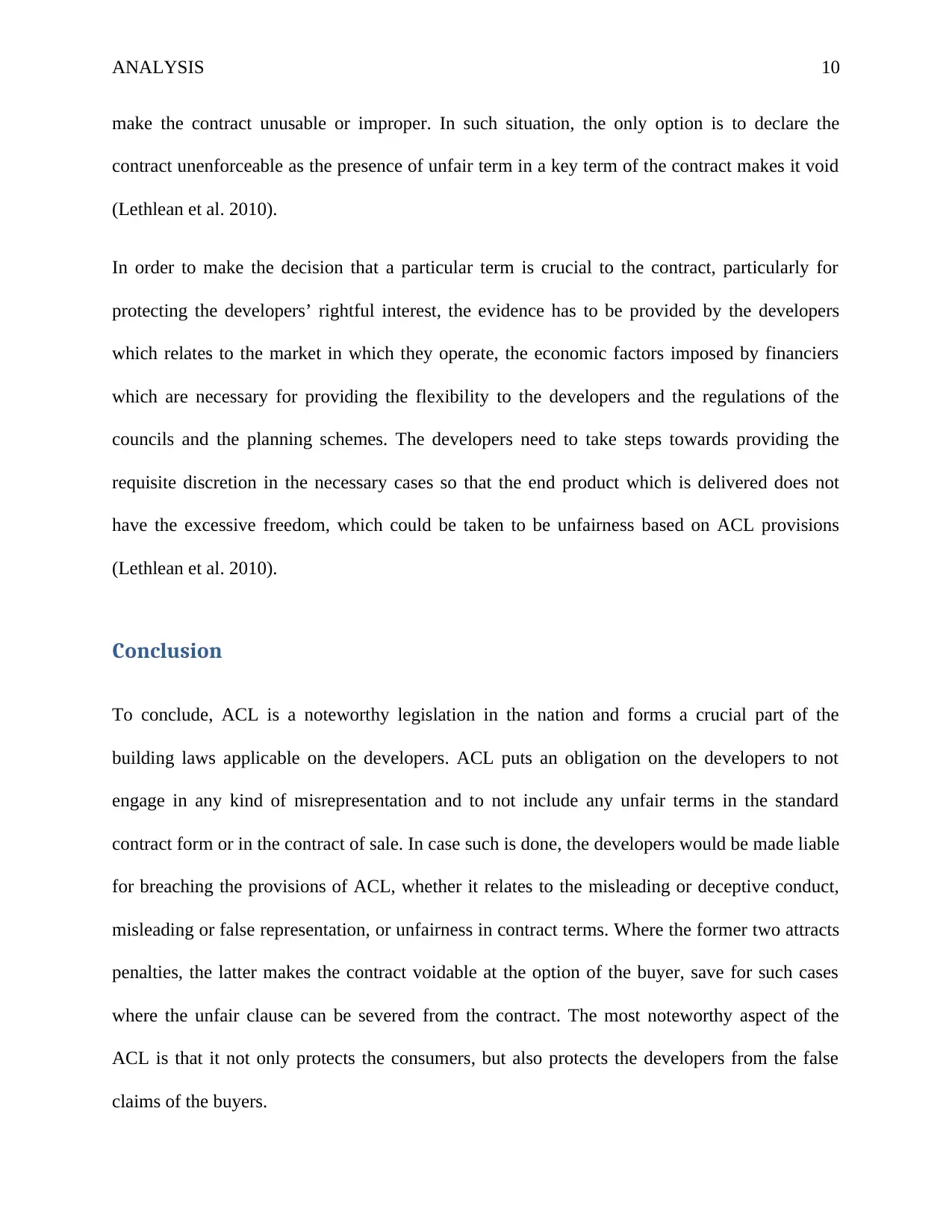
ANALYSIS 10
make the contract unusable or improper. In such situation, the only option is to declare the
contract unenforceable as the presence of unfair term in a key term of the contract makes it void
(Lethlean et al. 2010).
In order to make the decision that a particular term is crucial to the contract, particularly for
protecting the developers’ rightful interest, the evidence has to be provided by the developers
which relates to the market in which they operate, the economic factors imposed by financiers
which are necessary for providing the flexibility to the developers and the regulations of the
councils and the planning schemes. The developers need to take steps towards providing the
requisite discretion in the necessary cases so that the end product which is delivered does not
have the excessive freedom, which could be taken to be unfairness based on ACL provisions
(Lethlean et al. 2010).
Conclusion
To conclude, ACL is a noteworthy legislation in the nation and forms a crucial part of the
building laws applicable on the developers. ACL puts an obligation on the developers to not
engage in any kind of misrepresentation and to not include any unfair terms in the standard
contract form or in the contract of sale. In case such is done, the developers would be made liable
for breaching the provisions of ACL, whether it relates to the misleading or deceptive conduct,
misleading or false representation, or unfairness in contract terms. Where the former two attracts
penalties, the latter makes the contract voidable at the option of the buyer, save for such cases
where the unfair clause can be severed from the contract. The most noteworthy aspect of the
ACL is that it not only protects the consumers, but also protects the developers from the false
claims of the buyers.
make the contract unusable or improper. In such situation, the only option is to declare the
contract unenforceable as the presence of unfair term in a key term of the contract makes it void
(Lethlean et al. 2010).
In order to make the decision that a particular term is crucial to the contract, particularly for
protecting the developers’ rightful interest, the evidence has to be provided by the developers
which relates to the market in which they operate, the economic factors imposed by financiers
which are necessary for providing the flexibility to the developers and the regulations of the
councils and the planning schemes. The developers need to take steps towards providing the
requisite discretion in the necessary cases so that the end product which is delivered does not
have the excessive freedom, which could be taken to be unfairness based on ACL provisions
(Lethlean et al. 2010).
Conclusion
To conclude, ACL is a noteworthy legislation in the nation and forms a crucial part of the
building laws applicable on the developers. ACL puts an obligation on the developers to not
engage in any kind of misrepresentation and to not include any unfair terms in the standard
contract form or in the contract of sale. In case such is done, the developers would be made liable
for breaching the provisions of ACL, whether it relates to the misleading or deceptive conduct,
misleading or false representation, or unfairness in contract terms. Where the former two attracts
penalties, the latter makes the contract voidable at the option of the buyer, save for such cases
where the unfair clause can be severed from the contract. The most noteworthy aspect of the
ACL is that it not only protects the consumers, but also protects the developers from the false
claims of the buyers.
Paraphrase This Document
Need a fresh take? Get an instant paraphrase of this document with our AI Paraphraser

ANALYSIS 11
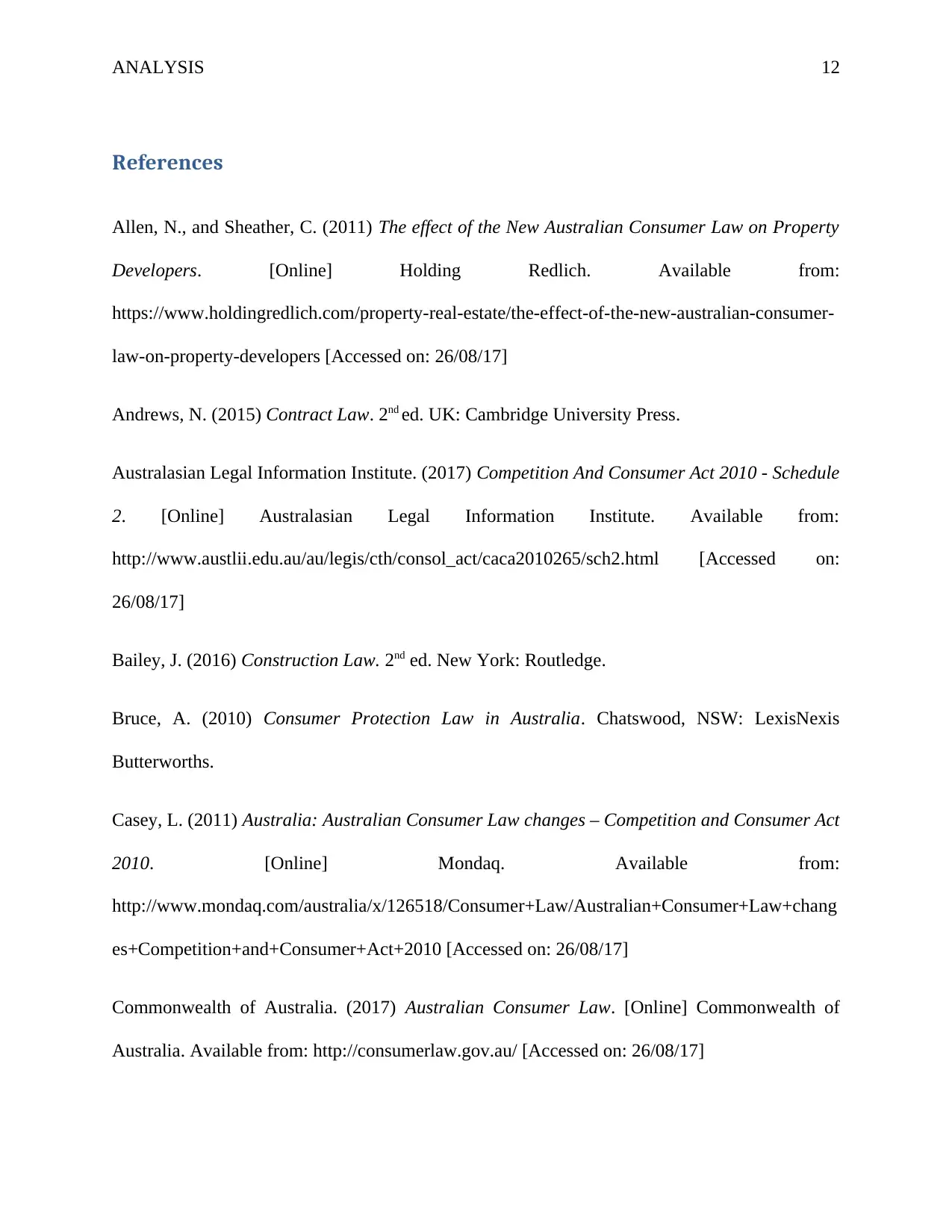
ANALYSIS 12
References
Allen, N., and Sheather, C. (2011) The effect of the New Australian Consumer Law on Property
Developers. [Online] Holding Redlich. Available from:
https://www.holdingredlich.com/property-real-estate/the-effect-of-the-new-australian-consumer-
law-on-property-developers [Accessed on: 26/08/17]
Andrews, N. (2015) Contract Law. 2nd ed. UK: Cambridge University Press.
Australasian Legal Information Institute. (2017) Competition And Consumer Act 2010 - Schedule
2. [Online] Australasian Legal Information Institute. Available from:
http://www.austlii.edu.au/au/legis/cth/consol_act/caca2010265/sch2.html [Accessed on:
26/08/17]
Bailey, J. (2016) Construction Law. 2nd ed. New York: Routledge.
Bruce, A. (2010) Consumer Protection Law in Australia. Chatswood, NSW: LexisNexis
Butterworths.
Casey, L. (2011) Australia: Australian Consumer Law changes – Competition and Consumer Act
2010. [Online] Mondaq. Available from:
http://www.mondaq.com/australia/x/126518/Consumer+Law/Australian+Consumer+Law+chang
es+Competition+and+Consumer+Act+2010 [Accessed on: 26/08/17]
Commonwealth of Australia. (2017) Australian Consumer Law. [Online] Commonwealth of
Australia. Available from: http://consumerlaw.gov.au/ [Accessed on: 26/08/17]
References
Allen, N., and Sheather, C. (2011) The effect of the New Australian Consumer Law on Property
Developers. [Online] Holding Redlich. Available from:
https://www.holdingredlich.com/property-real-estate/the-effect-of-the-new-australian-consumer-
law-on-property-developers [Accessed on: 26/08/17]
Andrews, N. (2015) Contract Law. 2nd ed. UK: Cambridge University Press.
Australasian Legal Information Institute. (2017) Competition And Consumer Act 2010 - Schedule
2. [Online] Australasian Legal Information Institute. Available from:
http://www.austlii.edu.au/au/legis/cth/consol_act/caca2010265/sch2.html [Accessed on:
26/08/17]
Bailey, J. (2016) Construction Law. 2nd ed. New York: Routledge.
Bruce, A. (2010) Consumer Protection Law in Australia. Chatswood, NSW: LexisNexis
Butterworths.
Casey, L. (2011) Australia: Australian Consumer Law changes – Competition and Consumer Act
2010. [Online] Mondaq. Available from:
http://www.mondaq.com/australia/x/126518/Consumer+Law/Australian+Consumer+Law+chang
es+Competition+and+Consumer+Act+2010 [Accessed on: 26/08/17]
Commonwealth of Australia. (2017) Australian Consumer Law. [Online] Commonwealth of
Australia. Available from: http://consumerlaw.gov.au/ [Accessed on: 26/08/17]
⊘ This is a preview!⊘
Do you want full access?
Subscribe today to unlock all pages.

Trusted by 1+ million students worldwide
1 out of 14
Related Documents
Your All-in-One AI-Powered Toolkit for Academic Success.
+13062052269
info@desklib.com
Available 24*7 on WhatsApp / Email
![[object Object]](/_next/static/media/star-bottom.7253800d.svg)
Unlock your academic potential
Copyright © 2020–2025 A2Z Services. All Rights Reserved. Developed and managed by ZUCOL.





